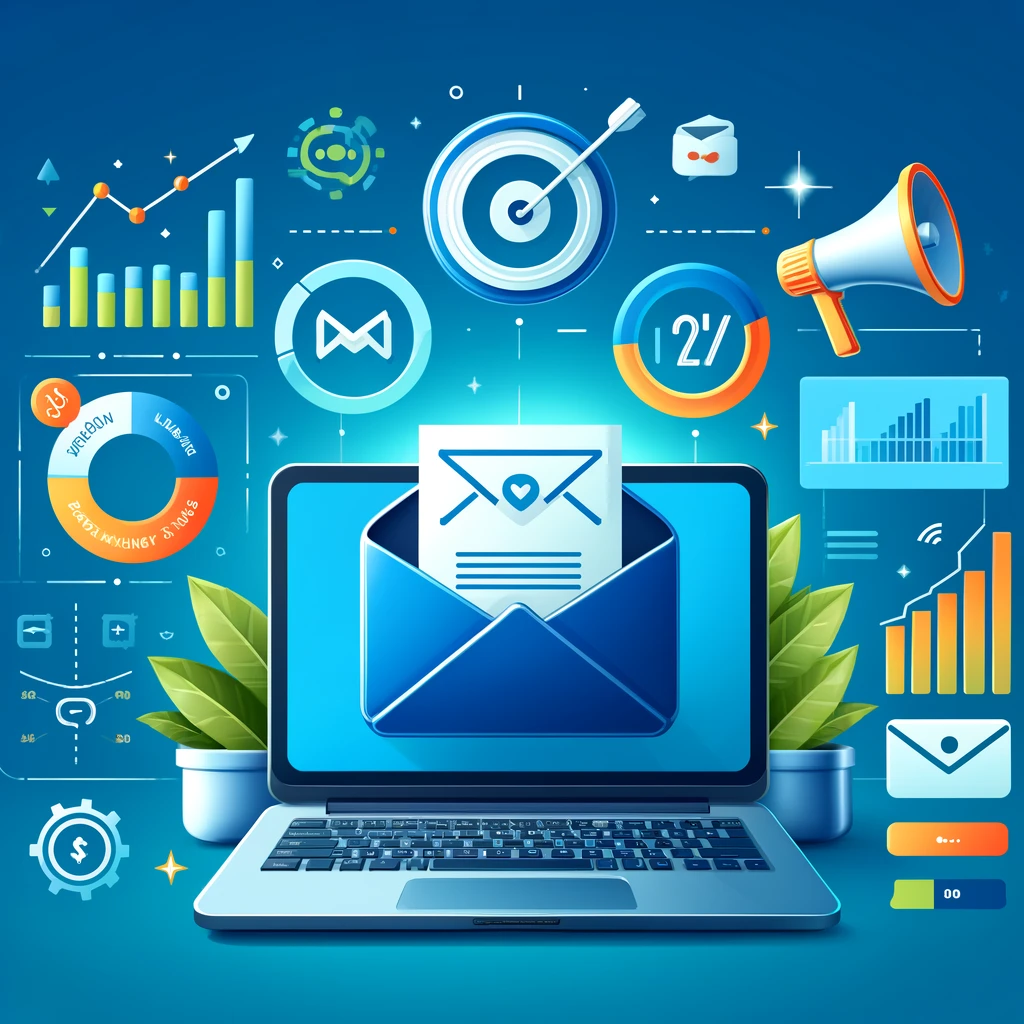
Email marketing remains one of the most powerful tools for businesses aiming to boost their sales. Did you know that for every 1 spent on email marketing, the average return on investment (ROI) is £42? Email marketing delivers impressive results despite the rise of social media and other digital channels. However, achieving such high ROI isn’t a given; it requires implementing effective email marketing strategies that engage your audience and drive conversions. This post will walk you through 10 proven techniques to transform your email marketing efforts and significantly boost your sales.
The secret to successful email marketing lies not just in sending emails but in sending the right emails to the right people at the right time. We’ve covered you, from building a high-quality email list to crafting compelling content and optimizing your email design. Plus, we’ll share some lesser-known tips that can give you an edge over your competition. Ready to dive in? Let’s get started!
Section 1: Understanding the Basics of Effective Email Marketing
Definition and Importance:
Email marketing involves sending promotional messages or newsletters to people via email. This direct form of communication allows businesses to build relationships with potential and current customers, keeping them informed and engaged. Effective email marketing strategies are crucial because they help convert prospects into customers and turn one-time buyers into loyal, raving fans.
Email marketing is essential for several reasons:
- It directly communicates with your audience, allowing you to share personalized content tailored to their interests.
- It is cost-effective, offering one of the highest ROIs among digital marketing channels.
- Email marketing is measurable, giving you insights into how your campaigns are performing and how you can improve them.
Benefits of Effective Email Marketing Strategies:
When done correctly, email marketing can significantly improve customer engagement. By sending targeted and relevant content, you can keep your audience interested in your brand and encourage them to take action. This increased engagement often translates into higher conversion rates, as recipients are more likely to purchase when they find the content valuable and relevant.
Furthermore, email marketing allows you to track and analyze your campaigns’ performance, giving you the data you need to optimise your strategies continuously. You can measure open, click-through, and conversion rates and use this information to refine your approach. Effective email marketing strategies can lead to better customer retention, higher sales, and a more substantial brand presence.
Section 2: Building a High-Quality Email List
Strategy 1: Utilize Opt-In Forms:
Opt-in forms are essential for growing your email list with high-quality subscribers. These forms should be strategically placed on your website, such as on the homepage, blog posts, and landing pages. Ensure they are easy to fill out and only ask for essential information, like the email address and first name. Offering incentives like free e-books, discounts, or exclusive content can encourage visitors to sign up.
To maximize the effectiveness of your opt-in forms, consider using pop-ups and slide-ins that appear after a visitor spends a certain amount of time on your site or scrolls down a specific percentage of the page. These methods capture the attention of engaged visitors, who are more likely to be interested in your content and offers. Another practical approach is to embed sign-up forms within your blog posts and articles, where readers are already engaged with your content.
Strategy 2: Leverage Social Media:
Social media platforms are excellent channels for promoting your email sign-up forms. Share links to your sign-up page on your social media profiles and in your posts to drive traffic to your email list. You can also use social media ads targeting your followers and lookalike audiences to reach potential subscribers likely to be interested in your content.
Engaging with your social media followers and encouraging them to join your email list can create a more integrated marketing strategy. By consistently promoting your sign-up form and offering valuable incentives, you can build a high-quality email list of engaged subscribers interested in your offer. Collaborations with influencers and social media contests are great ways to attract new subscribers.

Section 3: Crafting Compelling Email Content
Strategy 3: Personalization:
Personalization is critical to making your emails more relevant and engaging for your audience. Start by addressing your recipients by their first names, which creates a more personalized and friendly tone. Additionally, segment your email list based on demographics, purchase history, and engagement levels to tailor your messages to different audience segments.
Sending personalized product recommendations and content that aligns with each recipient’s interests can significantly boost engagement. For example, suppose a subscriber recently purchased a product from your website. In that case, you can follow up with related product suggestions or helpful tips on using their purchase. This level of personalization shows that you understand and value your customers, leading to higher satisfaction and loyalty.
Strategy 4: Engaging Subject Lines:
The subject line is the first thing your recipients see, and it plays a crucial role in determining whether they will open your email. To create attention-grabbing subject lines, focus on being clear, concise, and intriguing. Use action verbs and urgency to encourage recipients to open the email immediately. A/B testing different subject lines can help you determine which ones resonate best with your audience.
Including personalization in your subject lines, such as using the recipient’s recipients name or referencing their recent activity, can also increase open rates. Emojis can add a fun and eye-catching element. Use them sparingly to ensure they are relevant to your message. A compelling subject line should create curiosity and hint at the email’s value, enticing the reader to learn more.
Strategy 5: High-Quality Copywriting:
Crafting clear, concise, and persuasive email content is essential for keeping your audience engaged. Your emails should be easy to read and provide value to the recipient. Focus on using a conversational tone that makes your message more relatable and engaging. Break up your text with bullet points and subheadings to make it more scannable.
In addition to a strong opening, ensure your emails include a compelling call-to-action (CTA) that encourages recipients to take the desired next step, whether purchasing, signing up for an event, or reading more content. Providing valuable information and clear instructions will increase the likelihood of your audience taking action.
Section 4: Optimizing Email Design and Layout
Strategy 6: Mobile Optimization:
With the increasing use of smartphones, ensuring your emails are mobile-friendly is crucial. A significant portion of your audience will likely open your emails on their mobile devices, so your design should be responsive and look good on all screen sizes. Use a single-column layout, large fonts, and clear CTAs that are easy to tap on small screens.
Mobile optimization also includes reducing the size of your images to ensure quick loading times. Large images can slow down loading, leading to a poor user experience and potentially higher bounce rates. Testing your emails across various devices and email clients can help you identify and fix any issues before sending them to your entire list.
Strategy 7: Visual Appeal:
A visually appealing email can capture your recipients’ attention and make your content more engaging. Use high-quality images and graphics that are relevant to your message. However, be mindful of not overcrowding your email with too many visuals, which can be distracting and affect readability.
Balance your text and visuals using whitespace to create a clean and organized layout. This approach helps direct the reader’s attention to the most critical parts of your email, such as the CTA. Additionally, consistent branding elements like your logo, colours, and fonts help reinforce your brand identity and make your emails more recognizable.
Section 5: Enhancing Deliverability and Open Rates
Strategy 8: Email Scheduling:
Timing can significantly impact the success of your email campaigns. Research shows that certain times and days are more effective for sending emails, but these can vary based on your audience. Mid-week days like Tuesday and Thursday mornings tend to perform well. However, testing different send times and analyzing your open rates can help you determine the best schedule for your specific audience.
Consistency in your email frequency is also important. Sending emails too frequently can lead to unsubscribes, while too infrequently can cause your audience to forget about you. Establish a regular cadence that keeps your brand at the top of your mind without overwhelming your subscribers. Communicating this schedule when they sign up can also set expectations and build trust.
Strategy 9: Clean Your Email List:
Maintaining a clean email list is essential for ensuring high deliverability rates. Over time, email lists can accumulate inactive subscribers who no longer engage with your content. Regularly removing these inactive contacts can improve your sender’s reputation and reduce the chances of your emails being marked as spam.
Segmenting your list to identify and re-engage inactive subscribers before removing them can also be beneficial. Send a re-engagement campaign offering an incentive to stay subscribed or asking for feedback on why they are no longer interested. This effort can help you retain valuable contacts and improve the overall health of your email list.

Section 6: Analyzing and Improving Performance
Strategy 10: Monitoring Metrics:
Tracking the performance of your email campaigns is crucial for understanding what works and what doesn’t. Key monitoring metrics include open, click-through, conversion, and unsubscribe rates. These metrics provide insights into how your audience engages with your emails and where there might be room for improvement.
Using analytics tools to measure and analyze these metrics can help you identify trends and patterns. For instance, if you notice that certain types of content consistently receive higher engagement, you can focus more on those topics in future campaigns. Regularly reviewing and adjusting your strategies based on performance data will ensure continuous improvement.
Continuous Improvement:
A/B testing is an effective way to experiment with different elements of your emails and find out what resonates best with your audience. You can test various aspects, such.
As subject lines, email copy, images, CTAs, and send times. By comparing the performance of different versions, you can make data-driven decisions to optimize your campaigns.
Adapting your strategies based on feedback and performance data is critical to staying relevant and practical. Encourage subscribers to share their preferences and feedback through surveys and direct interactions. This information can provide valuable insights into how you can better meet their needs and expectations, ultimately leading to higher engagement and sales.
Conclusion – Effective Email Marketing Strategies
In this post, we have covered ten proven effective email marketing strategies to boost your sales. From building a high-quality email list to crafting compelling content, optimizing design, and continuously improving performance, these strategies can help you maximize the impact of your email marketing efforts. Implementing these tactics can enhance customer engagement, drive conversions, and achieve better ROI.
Email marketing is a dynamic and evolving field, and staying up-to-date with the latest trends and best practices is essential. We encourage you to experiment with these strategies, track your results, and continuously refine your approach. Remember, the key to successful email marketing is delivering value to your audience and building strong relationships with your subscribers. Happy emailing!
Additional Resources
Top 10 Email Marketing Best Practices for Boosting Your Campaigns
Personalised Email Strategies: Unlock the Secrets to Higher Profits
The Power of Personalised Email Campaigns
Email Marketing Tools:
- Mailchimp
- Aweber
- Constant Contact
- Sendinblue
- HubSpot Email Marketing
Further Reading:
- “Email Marketing Rules” “by Chad S. White
- “The New Email Revolution” “by Robert W. Bly
Following these strategies and utilising the recommended tools and resources can create powerful email marketing campaigns that drive sales and build lasting customer relationships.
